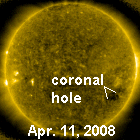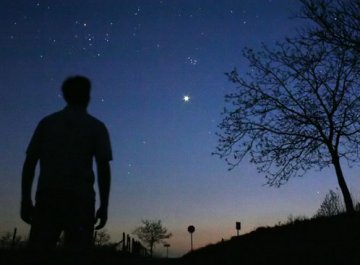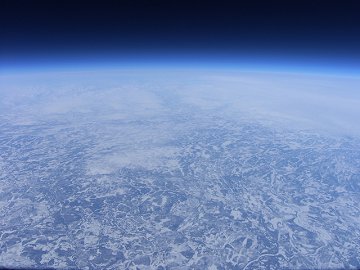|   SPACE WEATHER SPACE WEATHER
Current
Conditions
Solar Wind
speed: 511.7 km/s
density: 3.5 protons/cm3
explanation | more data
Updated: Today at 2246 UT X-ray Solar Flares
6-hr max: A0 2245 UT Apr11
24-hr: A0 0530 UT Apr11
explanation | more data
Updated: Today at 2245 UT
Daily Sun: 11 Apr '07

The sun is blank today--no sunspots. Credit: SOHO/MDI
Sunspot Number: 0
What is the sunspot number?
Updated: 10 Apr 2007 Far Side of the Sun

This holographic image reveals no sunspots on the far side of the sun. Image credit: SOHO/MDI Interplanetary Mag. Field
Btotal: 5.1 nT
Bz: 4.6 nT north
explanation | more data
Updated: Today at 2246 UT Coronal Holes:

Earth is inside a weak solar wind stream flowing from the indicated coronal hole. Credit: SOHO Extreme UV telescope
 SPACE WEATHER SPACE WEATHER
NOAA
Forecasts
Solar Flares: Probabilities for a medium-sized (M-class) or a major (X-class) solar flare during the next 24/48 hours are tabulated below.
Updated at 2007 Apr 11 2203 UTC
| FLARE | 0-24 hr | 24-48 hr | | CLASS M | 01 % | 01 % | | CLASS X | 01 % | 01 % |
Geomagnetic Storms: Probabilities for significant disturbances in Earth's magnetic field are given for three activity levels: active, minor storm, severe storm
Updated at 2007 Apr 11 2203 UTC
Mid-latitudes | 0-24 hr | 24-48 hr | | ACTIVE | 20 % | 15 % | | MINOR | 10 % | 05 % | | SEVERE | 01 % | 01 % |
High latitudes | 0-24 hr | 24-48 hr | | ACTIVE | 25 % | 15 % | | MINOR | 10 % | 05 % | | SEVERE | 01 % | 01 % |
|  Did you miss last night's auroras? Next time get a wake-up call from Spaceweather PHONE. Did you miss last night's auroras? Next time get a wake-up call from Spaceweather PHONE.
BLANK SUN: The sunspot number has been zero for eight consecutive days. This may seem like a long time, but the sun can go much longer without sunspots. For instance, during the previous solar minimum in 1996, the sun was once blank for 37 consecutive days between Sept. 13th and Oct. 19th of that year. How long will the current "blank" last? Stay tuned. VENUS AND THE PLEIADES: Tonight, Venus and the Pleiades are side-by-side. To see the conjunction, simply go outside after sunset and look west. The scene will look something like this: 
Photo details: Canon EOS 350D, ISO800, 8 sec exposure.
"I was driving home, but had to pull over and enjoy this beautiful pair in the evening sky," says photographer Ivica Skokic of Semovci, Croatia. Venus and the Pleiades are a model of contrast. Consider the following: -
Venus is ancient; the planet formed 4.5 billion years ago. The Pleiades are young; the cluster's hot, blue stars are barely 100 million years old. -
Venus is hellish; the planet's surface is hot enough to melt lead and its clouds are laced with sulfuric acid. The Pleiades are barely formed and full of promise. -
Venus is intensely bright; its clouds reflect 65% of all light that hits the planet. The Pleiades are dimmed by distance; the cluster is 400 light years away. So different, yet they look so nice together. Take a look! [sky map] more images: from Steve Irvine of Big Bay, Ontario, Canada; from Thad V'Soske of Western Colorado, USA; from Peter Heinzen of Raron, Walliser Alps, Switzerland; from Mark Riddick of Staunton, Virginia; from Pete Lawrence of Selsey, West Sussex, UK; from John Stetson of Falmouth, Maine; from Chuck Boren of Livonia, Michigan; from James Willinghan of Elkridge, Maryland; from Michel Hersen of Portland, Oregon; STRATOSPHERIC PHOTOGRAPHY: Consider it a test flight. Swedish University students Jörgen Hedin and Michael Erneland wondered what it would be like to send an ordinary digital camera into the stratosphere and take a picture of the scenery. So on March 28th they launched a weather balloon with a Samsung DigiMax Pro 815 onboard, and here is the result: 
"This photo was taken about two and a half hours into the flight at an altitude of 25 km," says Hedin. "The balloon was straight above the city of Rovaniemi in Finland. In the high resolution image one can see the Swedish/Norwegian mountains in the distance." At an altitude of 25 km, the balloon was above 95% of Earth's atmosphere. The air was only a few percent as dense as air at sea level, and the temperature was about 55 degrees C below zero. These are conditions typical of the planet Mars! How appropriate that the black of space is visible just over the horizon. The test flight was a big success and more flights are planned. Stay tuned for photos of meteors, auroras, stars and planets--the possibilities are stratospheric. BONUS: Click here to browse photos from a similar flight over Colorado, sponsored by NOAA's Earth Systems Research Laboratory in June 2006. | 
Potentially Hazardous Asteroids (PHAs) are space rocks larger than approximately 100m that can come closer to Earth than 0.05 AU. None of the known PHAs is on a collision course with our planet, although astronomers are finding new ones all the time.
On 11 Apr 2007 there were 855 known Potentially
Hazardous Asteroids April 2007 Earth-asteroid encounters | ASTEROID | DATE
(UT) | MISS DISTANCE | MAG. | SIZE
| | 2006 VV2 | Mar. 31 | 8.8 LD | 10 | 2 km | | 2007 FY20 | Apr. 2 | 5.3 LD | 19 | 50 m | | 2007 DS84 | Apr. 14 | 16 LD | 15 | 325 m | Notes: LD is a "Lunar Distance." 1 LD = 384,401 km, the distance between Earth and the Moon. 1 LD also equals 0.00256 AU. MAG is the visual magnitude of the asteroid on the date of closest approach.
|

